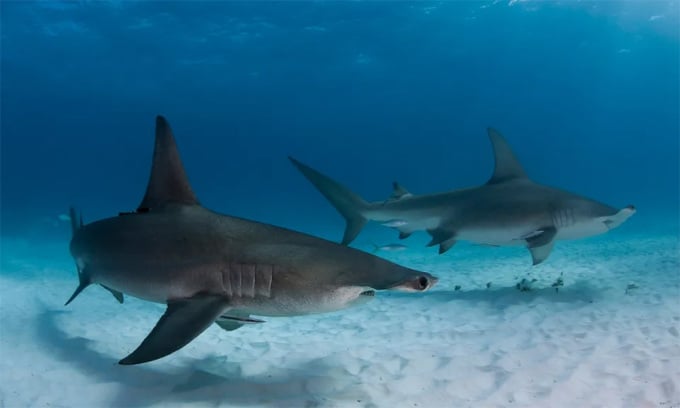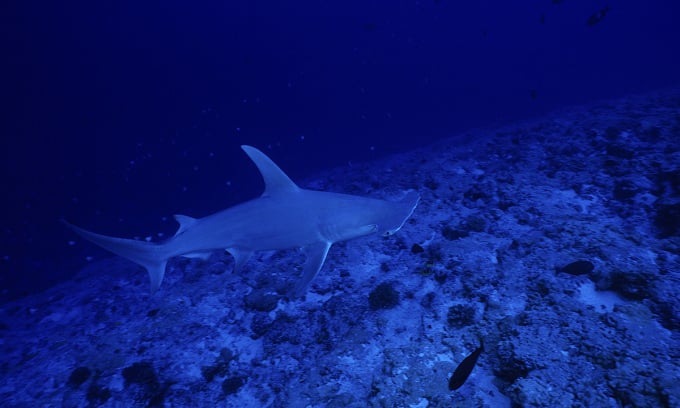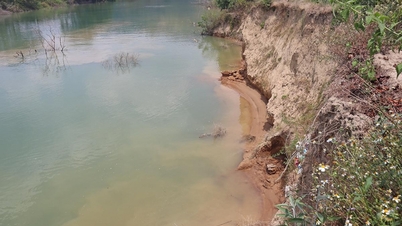Many female large hammerhead sharks congregate near the two coral islands of Rangiroa and Tikehau, possibly for hunting and breeding purposes.

In the summers of 2020 and 2021, 54 female hammerhead sharks gathered around two coral atolls in French Polynesia. Photo: Alastair Pollock Photography/Getty
Scientists have discovered a large, all-female group of large hammerhead sharks ( Sphyrna mokarran ) that have been unusually converging in the tropical waters of French Polynesia every summer for more than a decade, with numbers peaking around the full moon. The findings were published in the journal Frontiers in Marine Science on August 29th.
Hammerhead sharks congregate during the summer in the Southern Hemisphere (December–March) around open waters near the two atolls of Rangiroa and Tikehau in the Tuamotu Islands. An atoll is a circular island or reef surrounding a lagoon, formed when land erodes and sinks below the ocean surface.
During the summers of 2020 and 2021, the research team discovered 54 female large hammerhead sharks and one of unidentified sex around two coral atolls (located 15 km apart). They reported that more than half of the sharks were "seasonal residents," meaning they stayed there for up to six days a month for up to five months.
According to research, female sharks near the Rangiroa atoll are mainly concentrated in a location called the "hammerhead shark plateau" - an area 45-60 meters deep. Experts mostly observe them moving independently around the plateau's bottom.
The large hammerhead shark is classified as critically endangered in the International Union for Conservation of Nature (IUCN) Red List. They are solitary animals, so the presence of multiple females around the Rangiroa and Tikehau atolls suggests the area is a gathering point. It is likely they are not related but were attracted to the area by external factors. These factors appear to be related to the lunar cycle and the presence of the white-spotted eagle ray ( Aetobatus ocellatus ).

Sharks congregated in the highest numbers before and after the full moon during the summers of 2020 and 2021. Photo: Gerard Soury/Getty
The large hammerhead sharks are most concentrated around the time of the full moon in both summer and winter. The research team suggests that the brighter moonlight may help them hunt around the coral reef at night more effectively. Additionally, it's possible they are reacting to changes in the Earth's magnetic field as the moon's position shifts.
The gathering of large hammerhead sharks around the two coral islands coincides with the time when many white-spotted eagle rays flock to the lagoon to breed. The large hammerhead sharks hunt these rays, and their mating season is a predictable event that predators try to disrupt.
Additionally, rising water temperatures after the winter months may also attract large hammerhead sharks to the Tuamotu Islands. The team of scientists compared their observations with long-term data collected on coral islands and found that some individuals returned every summer for 12 years. They identified 30 more males and females from the old data and found that males were primarily present from August to October rather than during the summer. Thus, male large hammerhead sharks remain far from the locations where females live in the Southern Hemisphere during the summer, which may be related to their breeding season.
The lagoon, with its protected, warm, shallow waters, is a breeding ground for many shark species. The team of experts could not confirm this in their new study, but they are conducting further research to determine whether the two coral islands of Rangiroa and Tikehau are breeding grounds for the great hammerhead shark.
Thu Thao (According to Live Science )
Source link




![[Photo] Prime Minister Pham Minh Chinh presides over a meeting on private sector economic development.](/_next/image?url=https%3A%2F%2Fvphoto.vietnam.vn%2Fthumb%2F1200x675%2Fvietnam%2Fresource%2FIMAGE%2F2025%2F12%2F20%2F1766237501876_thiet-ke-chua-co-ten-40-png.webp&w=3840&q=75)






































































































Comment (0)